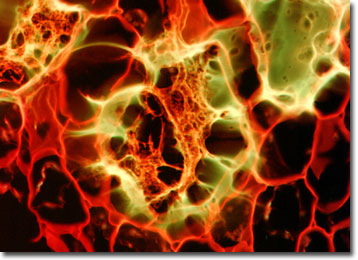Fluorescence Digital Image Gallery
Cactus Stem
Cactus plants are perennial succulents native to the Americas that are easily grown in almost all warm and arid climates around the world. The ability to sustain extreme temperatures makes them one of the heartiest plants on earth. Thorns, hairs, and layers of wax are some of the characteristics of cactuses that help to maintain their core temperature.

Large systems of roots and fleshy stems help the cactus plants to absorb large quantities of water when available and store it through long periods of drought. Almost 90 percent of the plant is water and it can withstand a 60 percent loss of water. The plant's waxy skin also helps to prevent water loss.
There are at least 1,650 species of cactus that occur in a great variety of forms: small round globes, vines, flat-stemmed ground-sprawling lobes, and enormous tree-like structures. Cactuses have delicate, but usually large, solitary flowers in shades of yellow, white, red and purple. Not all cactuses, however, bloom in the spring. The Christmas cactus Schlumbergera bridesii opens its blossoms after a period of cool temperatures or long nights, generally in the late fall or early winter. Some cactus blossoms are light sensitive and can only be seen at night or for a matter of hours. Flowers can be pollinated by wind, birds, insects, or bats.
Aside from garden and household decoration, the cactus plant is used as a vision-inducing drug in Native American religious ceremonies and is an important source of food in many parts of the world. A member of the genus Lophophora, peyote is a cactus widely known for its hallucinogenic effects caused by the alkaloid mescaline and grows only on the limestone soils of the Chihuahuan desert that spans from northern Mexico through southern Texas. For centuries this plant has been used by many of the Plains Indian tribes, including Navajo, Kiowa, Sioux, and Comanche, for inducing religious visions.
The prickly pear, which belongs to the genus Opuntia, is a cactus well known for its culinary value. The "cactus fruit" is popular in some countries, but hasn't been widely consumed in North America and Europe. Cactus enthusiasts are working to change that. Cactus steak has become a favorite in Southern Japan, cooked or raw. Other new dishes being developed and marketed are french-fried cactus, cactus chili, cactus burritos and even cactus ice cream, all on their way to stores and restaurants at a location near you.
The specimen presented here was imaged with a Nikon Eclipse E600 microscope operating with fluorite and/or apochromatic objectives and vertical illuminator equipped with a mercury arc lamp. Specimens were illuminated through Nikon dichromatic filter blocks containing interference filters and a dichroic mirror and imaged with standard epi-fluorescence techniques. Specific filters for the stained cactus thin section were a B-2E/C and Y-2E/C. Photomicrographs were captured with a Nikon DXM 1200 digital camera system coupled to the microscope with a lens-free C-mount adapter.
BACK TO THE FLUORESCENCE DIGITAL IMAGE GALLERY
